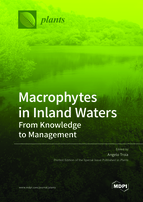Macrophytes in Inland Waters: From Knowledge to Management
A special issue of Plants (ISSN 2223-7747). This special issue belongs to the section "Plant Ecology".
Deadline for manuscript submissions: closed (28 February 2022) | Viewed by 30637
Special Issue Editor
Interests: aquatic plants; charophytes; wetlands; Mediterranean islands; conservation biology; taxonomy; Isoetes
Special Issues, Collections and Topics in MDPI journals
Special Issue Information
Dear Colleagues,
The importance of freshwater and the different inland aquatic ecosystems is becoming increasingly clear, and species living in those habitats are often threatened by human impact. Indeed, we sometimes witness the destruction of important wetlands or aquatic biotopes before we were able to appreciate their flora.
In addition, aquatic flora is often poorly known, probably because most of “classic” botanists often stop at the edge of the land/water border.
The aim of this Special Issue is to invite people studying aquatic plants (and charophytes) in inland waters to contribute to a better knowledge of these ecosystems, with basic research (involving taxonomy or ecology) or with applied research (involving the management of aquatic plants, or their use in assessing the quality of the waters or the quality of the environment), with a special focus on floating and submersed macrophytes (i.e., hydrophytes). Invasive alien aquatic species, of course, are also a possible subject.
Dr. Angelo TroiaGuest Editor
Manuscript Submission Information
Manuscripts should be submitted online at www.mdpi.com by registering and logging in to this website. Once you are registered, click here to go to the submission form. Manuscripts can be submitted until the deadline. All submissions that pass pre-check are peer-reviewed. Accepted papers will be published continuously in the journal (as soon as accepted) and will be listed together on the special issue website. Research articles, review articles as well as short communications are invited. For planned papers, a title and short abstract (about 100 words) can be sent to the Editorial Office for announcement on this website.
Submitted manuscripts should not have been published previously, nor be under consideration for publication elsewhere (except conference proceedings papers). All manuscripts are thoroughly refereed through a single-blind peer-review process. A guide for authors and other relevant information for submission of manuscripts is available on the Instructions for Authors page. Plants is an international peer-reviewed open access semimonthly journal published by MDPI.
Please visit the Instructions for Authors page before submitting a manuscript. The Article Processing Charge (APC) for publication in this open access journal is 2700 CHF (Swiss Francs). Submitted papers should be well formatted and use good English. Authors may use MDPI's English editing service prior to publication or during author revisions.
Keywords
- macrophytes
- hydrophytes
- charophytes
- wetlands
- aquatic habitats
- aquatic plants
- biogeography
- plant conservation
- plant ecology
- plant dispersal
- plant distribution
Related Special Issue
- Macrophytes in Inland Waters: From Knowledge to Management Ⅱ in Plants (2 articles)







